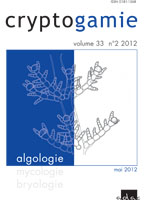The presence of dinoflagellates of the genus Ostreopsis along Mediterranean coasts was first observed in 1972, in the bay of Villefranche-sur-Mer. However, over the past ten years, harmful events related to this benthic dinoflagellate have been reported in Italian, Spanish, Greek, French, Tunisian and Algerian coastal areas. In France, during a hot period in August 2006, cases of dermatitis and respiratory problems were registered in Marseille area. At that time, a link to the proliferation of Ostreopsis was highlighted for the first time in that area. A specific monitoring was designed and implemented in the summer 2007. Two strains of Ostreopsis cf. ovata, collected in 2008 from Villefranche-sur-Mer and Morgiret coastal waters and grown in culture, were identified by molecular analysis and studied to characterise their growth and toxin profile. Liquid chromatography-mass spectrometry (LC-MS/MS) indicated that both strains produced ovatoxin-a (OVTX-a) as the major component (ca. 90%), and traces of palytoxin (PLTX). Toxin content was determined at the end of the exponential growth phase with highest concentration of 55 pg.cell-1 of OVTX-a and 2.5 pg.cell-1 of PLTX.
How to translate text using browser tools
1 May 2012
Ostreopsis cf. ovata in the French Mediterranean Coast: Molecular Characterisation and Toxin Profile
Véronique Sechet,
Manoella Sibat,
Nicolas Chomérat,
Elisabeth Nézan,
Hubert Grossel,
Jean-Brieuc Lehebel-Peron,
Thierry Jauffrais,
Nicolas Ganzin,
Françoise Marco-Miralles,
Rodolphe Lemée,
Zouher Amzil
ACCESS THE FULL ARTICLE
It is not available for individual sale.
This article is only available to subscribers.
It is not available for individual sale.
It is not available for individual sale.

Cryptogamie, Algologie
Vol. 33 • No. 2
May 2012
Vol. 33 • No. 2
May 2012
Mediterranean Sea
Ostreopsis cf. ovata
ovatoxin-a
palytoxin




